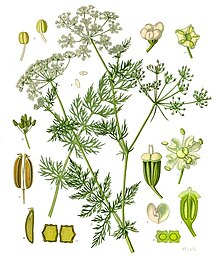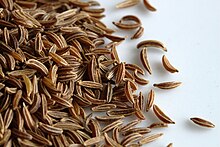Caraway
| Caraway | |
|---|---|

| |
| Scientific classification | |
| Kingdom: | Plantae |
| Clade: | Tracheophytes |
| Clade: | Angiosperms |
| Clade: | Eudicots |
| Clade: | Asterids |
| Order: | Apiales |
| Family: | Apiaceae |
| Genus: | Carum |
| Species: | C. carvi
|
| Binomial name | |
| Carum carvi | |
Caraway, also known as meridian fennel and Persian cumin (Carum carvi), is a biennial plant in the family Apiaceae, native to western Asia, Europe, and North Africa.[1][2]

| Nutritional value per 100 g (3.5 oz) | |||||||||||||||||||||||||||||||||||||||||||||
|---|---|---|---|---|---|---|---|---|---|---|---|---|---|---|---|---|---|---|---|---|---|---|---|---|---|---|---|---|---|---|---|---|---|---|---|---|---|---|---|---|---|---|---|---|---|
| Energy | 1,390 kJ (330 kcal) | ||||||||||||||||||||||||||||||||||||||||||||
49.90 g | |||||||||||||||||||||||||||||||||||||||||||||
| Sugars | 0.64 g | ||||||||||||||||||||||||||||||||||||||||||||
| Dietary fiber | 38.0 g | ||||||||||||||||||||||||||||||||||||||||||||
14.59 g | |||||||||||||||||||||||||||||||||||||||||||||
| Saturated | 0.620 g | ||||||||||||||||||||||||||||||||||||||||||||
| Monounsaturated | 7.125 g | ||||||||||||||||||||||||||||||||||||||||||||
| Polyunsaturated | 3.272 g | ||||||||||||||||||||||||||||||||||||||||||||
19.77 g | |||||||||||||||||||||||||||||||||||||||||||||
| |||||||||||||||||||||||||||||||||||||||||||||
| Other constituents | Quantity | ||||||||||||||||||||||||||||||||||||||||||||
| Water | 9.87 g | ||||||||||||||||||||||||||||||||||||||||||||
| †Percentages estimated using US recommendations for adults,[3] except for potassium, which is estimated based on expert recommendation from the National Academies.[4] | |||||||||||||||||||||||||||||||||||||||||||||
Etymology
[edit]The etymology of "caraway" is unclear. Caraway has been called by many names in different regions, with names deriving from the Latin cuminum (cumin), the Greek karon (again, cumin), which was adapted into Latin as carum (now meaning caraway), and the Sanskrit karavi, sometimes translated as "caraway", but other times understood to mean "fennel".[5] English use of the term caraway dates to at least 1440, possibly having Arabic origin.[5][6]
Description
[edit]The plant is similar in appearance to other members of the carrot family, with finely divided, feathery leaves with thread-like divisions, growing on 20–30 cm (8–12 in) stems. The main flower stem is 30–60 cm (12–24 in) tall, with small white or pink flowers in compound umbels composed of 5–16 unequal rays 1–6 cm (0.4–2.4 in) long. Caraway fruits, informally called seeds, are smooth, crescent-shaped, laterally compressed achenes, around 3 mm (1⁄8 in) long, with five pale ridges and a distinctive pleasant smell when crushed.[7] It flowers in June and July.[7]
History
[edit]Caraway was mentioned by the early Greek botanist Pedanius Dioscorides as a herb and tonic.[citation needed] It was later mentioned in the Roman Apicius as an ingredient in recipes.[8] Caraway was known in the Arab world as karawiya, and cultivated in Morocco.[8]
Cultivation
[edit]This section needs additional citations for verification. (March 2022) |
The only species that is cultivated is Carum carvi, its fruits being used in many ways in cooking and in the preparation of medicinal products and liqueurs.[9]
The plant prefers warm, sunny locations and well-drained soil rich in organic matter. [10] In warmer regions, it is planted in the winter as an annual. In temperate climates, it is planted as a summer annual or biennial.[1]
It is widely established as a cultivated plant. The Netherlands, Poland and Germany are the top caraway producers.[11] Finland supplies about 28% (2011) of the world's caraway production from some 1500 farms, the high output occurring possibly from its favorable climate and latitudes, which ensure long summer hours of sunlight.[12]
Nutrition
[edit]Caraway seeds are 10% water, 50% carbohydrates, 20% protein, and 15% fat (table). In a 100 grams (3.5 oz) reference amount, caraway seeds are a rich source (20% or more of the Daily Value, DV) of protein, B vitamins (24–33% DV), vitamin C (25% DV), and several dietary minerals, especially iron (125% DV), phosphorus (81% DV), and zinc (58% DV) (table).
Phytochemicals
[edit]When ground, caraway seeds yield up to 7.5% of volatile oil, mostly D-carvone, and 15% fixed oil of which the major fatty acids are oleic, linoleic, petroselinic, and palmitic acids.[13]
Phytochemicals identified in caraway seed oil include thymol, o-cymene, γ‑terpinene, trimethylene dichloride, β-pinene, 2-(1-cyclohexenyl), cyclohexanone, β-phellandrene, 3-carene, α-thujene, and linalool.[13]
Uses
[edit]This section needs additional citations for verification. (September 2023) |
The fruits, usually used whole, have a pungent, anise-like flavor and aroma that comes from essential oils, mostly carvone, limonene, and anethole.[14] Caraway is used as a spice in breads, especially rye bread.[15] A common use of caraway is whole as an addition to rye bread – often called seeded rye or Jewish rye bread (see Borodinsky bread). Caraway seeds are often used in Irish soda bread and other baked goods.
Caraway may be used in desserts, liquors, casseroles, and other foods. Its leaves can be added to salads, stews, and soups, and are sometimes consumed as herbs, either raw, dried, or cooked, similar to parsley. The root is consumed as a winter root vegetable in some places, similar to parsnips.[15]
Caraway fruits are found in diverse European cuisines and dishes, for example sauerkraut, and the United Kingdom's caraway seed cake. In Austrian cuisine, it is used to season beef and, in German cuisine, pork. In Hungarian cuisine, it is added to goulash, and in Norwegian cuisine and Swedish cuisine, it is used for making caraway black bread.[15]
Caraway oil is used to for the production of Kümmel liquor in Germany and Russia, Scandinavian akvavit, and Icelandic brennivín.[15] Caraway can be infused in a variety of cheeses, such as havarti and bondost to add flavor. In Latvian cuisine, whole caraway seeds are added to the Jāņi sour milk cheese. In Oxford, where the plant appeared to have become naturalised in a meadow, the seeds were formerly offered on a tray by publicans to people who wished to disguise the odour of their drinker's breath.[16]
References
[edit]- ^ a b "North Carolina State Extension Gardener Plant Toolbox: Carum Carvi". North Carolina State University.
- ^ "Caraway". Word Crops Database. Retrieved February 16, 2016.
- ^ United States Food and Drug Administration (2024). "Daily Value on the Nutrition and Supplement Facts Labels". FDA. Archived from the original on March 27, 2024. Retrieved March 28, 2024.
- ^ National Academies of Sciences, Engineering, and Medicine; Health and Medicine Division; Food and Nutrition Board; Committee to Review the Dietary Reference Intakes for Sodium and Potassium (2019). "Chapter 4: Potassium: Dietary Reference Intakes for Adequacy". In Oria, Maria; Harrison, Meghan; Stallings, Virginia A. (eds.). Dietary Reference Intakes for Sodium and Potassium. The National Academies Collection: Reports funded by National Institutes of Health. Washington, DC: National Academies Press (US). pp. 120–121. doi:10.17226/25353. ISBN 978-0-309-48834-1. PMID 30844154. Retrieved December 5, 2024.
- ^ a b Katzer's Spice Pages: Caraway Caraway (Carum carvi L.)
- ^ Walter William Skeat, Principles of English Etymology, Volume 2, page 319. 1891 Words of Arabic Origin
- ^ a b Tutin TG. 1980. Umbellifers of the British Isles. BSBI Handbook No. 2. ISBN 0-90-115802-X
- ^ a b Pickersgill, Barbara (2005). Prance, Ghillean; Nesbitt, Mark (eds.). The Cultural History of Plants. Routledge. p. 157. ISBN 0415927463.
- ^ Tomanová, Eliška (1998). Wild Flowers. Prague, Czech Republic: Aventinum Nakladatelství. p. 113. ISBN 978-1-84067-046-2.
- ^ "Fragrant and Beautiful Herbs for Your Sunny Garden". The Spruce. Retrieved June 1, 2022.
- ^ Peter, K.V. (2012). Handbook of herbs and spices Volume 2. p. 229.
- ^ "Finland a Global Leader in Caraway Exports". FinnFacts. April 22, 2013. Archived from the original on April 19, 2014. Retrieved April 19, 2014.
- ^ a b Peter, K.V., ed. (2012). Handbook of Herbs and Spices, Volume 2. Woodhead Publishing Limited. p. 226. ISBN 978-0-85709-039-3.
- ^ María D. López; María J. Jordán; María J. Pascual-Villalobo (2008). "Toxic compounds in essential oils of coriander, caraway and basil active against stored rice pests". Journal of Stored Products Research. 44 (3): 273–278. doi:10.1016/j.jspr.2008.02.005.
- ^ a b c d Rodale's Illustrated Encyclopedia of Herbs
- ^ Mabey R. 1996. Flora Britannica. Sinclair-Stevenson ISBN 1-85-619377-2
External links
[edit]- Chisholm, Hugh, ed. (1911). . Encyclopædia Britannica. Vol. 5 (11th ed.). Cambridge University Press. p. 303.
